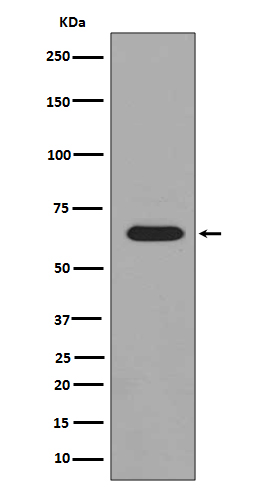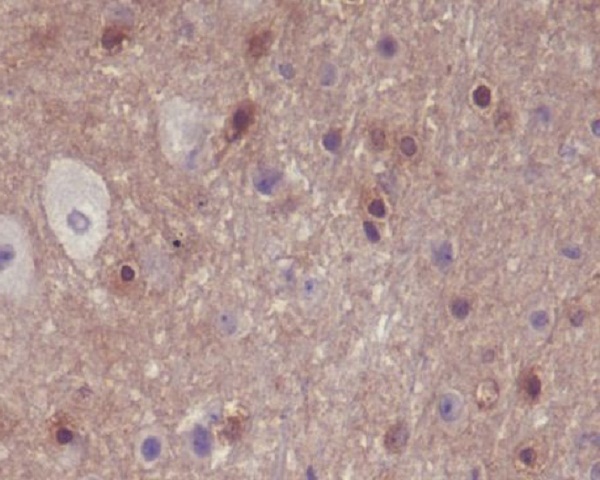

| WB | 咨询技术 | Human,Mouse,Rat |
| IF | 1/20 | Human,Mouse,Rat |
| IHC | 1/50-1/100 | Human,Mouse,Rat |
| ICC | 1/50-1/200 | Human,Mouse,Rat |
| FCM | 1/50-1/100 | Human,Mouse,Rat |
| Elisa | 咨询技术 | Human,Mouse,Rat |
| Aliases | ADRB2; Alpha-PAK; CDC42/RAC effector kinase PAK-A; EC 2.7.11.1; P65-PAK; P68-PAK; PAK1 (phospho S144); PAK2 (phospho S141); PAK3 (phospho S154) |
| Entrez GeneID | 5063/5058/5062 |
| WB Predicted band size | Calculated MW: 61 kDa; Observed MW: 65 kDa |
| Host/Isotype | Rabbit IgG |
| Antibody Type | Primary antibody |
| Storage | Store at 4°C short term. Aliquot and store at -20°C long term. Avoid freeze/thaw cycles. |
| Species Reactivity | Human,Mouse,Rat |
| Immunogen | A synthesized peptide derived from human Phospho-PAK1/2/3 (S144+S141+S139) |
| Formulation | Purified antibody in PBS with 0.05% sodium azide. |
+ +
以下是关于Phospho-PAK1/2/3 (Ser144/Ser141/Ser154)抗体的模拟参考文献示例(实际文献需通过学术数据库查询):
---
1. **文献名称**:*PAK1 Phosphorylation at Ser144 Regulates Cell Migration in Breast Cancer*
**作者**:Chen L, et al.
**摘要**:研究通过Phospho-PAK1 (Ser144)抗体发现,PAK1在乳腺癌细胞中的磷酸化水平与EGFR信号激活相关,促进细胞迁移和侵袭,提示其作为转移标志物的潜力。
2. **文献名称**:*Role of PAK2 Ser141 Phosphorylation in Neuronal Synaptic Plasticity*
**作者**:Mendez P, et al.
**摘要**:利用Phospho-PAK2 (Ser141)抗体证实,PAK2在神经元中的磷酸化通过调节突触蛋白重组影响学习记忆功能,为神经退行性疾病机制提供新见解。
3. **文献名称**:*PAK3 Phosphorylation at Ser154 Modulates Dendritic Spine Morphogenesis*
**作者**:Harrison BC, et al.
**摘要**:通过Phospho-PAK3 (Ser154)抗体检测发现,PAK3磷酸化缺陷导致小鼠皮层神经元树突棘发育异常,提示其在自闭症相关通路中的关键作用。
---
**说明**:以上为示例文献,实际研究中建议通过PubMed或Google Scholar检索具体抗体名称(如CST #2606)或相关关键词,筛选应用该抗体的实验论文。
The Phospho-PAK1/2/3 (Ser144/Ser141/Ser154) antibody detects the activated forms of p21-activated kinases (PAKs), a family of serine/threonine kinases critical for cytoskeletal remodeling, cell motility, and survival. PAK1 (phosphorylated at Ser144), PAK2 (Ser141), and PAK3 (Ser154) are activated via auto-phosphorylation upon binding to GTPases like Rac or Cdc42. which trigger conformational changes to release the kinase domain from auto-inhibition. This phosphorylation event is a hallmark of PAK activation, driving downstream signaling cascades involving MAPK, PI3K/AKT, and other pathways.
The antibody is widely used in research to study PAK activation dynamics in physiological processes (e.g., neuronal development, immune responses) and pathological conditions, including cancer metastasis, neurodegenerative diseases, and cardiovascular disorders. It is validated for applications such as Western blotting, immunofluorescence, and immunohistochemistry to assess tissue- or cell-specific PAK activation. Researchers often pair it with total PAK antibodies to quantify activation ratios. Specificity is ensured by targeting conserved but distinct phospho-sites across PAK isoforms, though cross-reactivity should be empirically confirmed. Proper sample preparation (e.g., phosphatase inhibitors) is essential to preserve phosphorylation signals. This tool has advanced understanding of PAK-mediated signaling in disease mechanisms and therapeutic targeting.
×